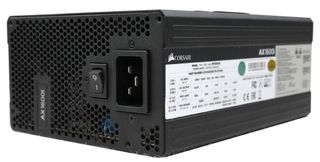Corsair AX1600i PSU Review
Why you can trust Tom's Hardware
Final Analysis
Corsair clearly states that this is not just another high-end PSU, but rather the only one in its class. Given extraordinary performance through our benchmarks and the platform's novelties, we have to agree. We waited years for a competitor to dethrone Corsair's AX1500i, and in the end it was another Corsair power supply to post higher overall performance.
The use of a cutting-edge PFC circuit in combination with a fully digital platform seems to be the key for record-setting performance. Besides its super efficiency, the AX1600i also offers great load regulation, amazing transient response, a long hold-up time, and unparalleled ripple suppression. Moreover, our great benchmark results are accompanied by quiet operation, enabled by a relaxed fan profile and a high-quality FDB fan. Using the Corsair Link software, you're able to choose between three fan modes: performance, balanced, and quiet. For our noise measurements, we used the default "balanced" profile.

Thanks to digital control, innovative features like the totem-pole PFC converter can be used to offer efficiency levels that simply aren't possible from older analog designs (at least until an analog controller for this type of PFC converter becomes available).
Another major feature of the AX1600i is its use of GaN FETs, which have low gate charge and output capacitance, allowing them to be switched at extremely high speeds with significantly lower switching losses compared to silicon FETs. The high power density that GaN FETs offer theoretically allow them to populate much smaller enclosures. So, we expect tomorrow's high-capacity PSUs to be much more compact than what we have today. It might even be the right time for Intel to start working on a new ATX specification that'll only need one rail and the 5VSB.
Considering that GaN-based solutions can be offered in a package that contains everything from FETs to drivers and controllers, a significant part of the rectification that currently takes place on a PSU's secondary side can be moved onto the components, minimizing energy losses while providing better transient response. Such a huge step requires lots of development time, though. Beyond just Intel and the PSU manufacturers, every component maker needs to modify their products and include those special DC-DC converters.
For the time being, Corsair's AX1600i signals a new era in the PSU design, just like the AX1200i did several years ago when it introduced digital control to the masses.
Corsair and Flextronics teamed up to deliver the best desktop PSU that money can buy. For their efforts (and the resulting outcome), both companies deserve our praise. If you can afford this product's price tag, reaching 450 bucks, and you need so much power along with the highest possible efficiency, then the AX1600i is a one way road.
MORE: Best Power Supplies
MORE: How We Test Power Supplies
MORE: All Power Supply Content
Current page: Final Analysis
Prev Page Performance, Value, Noise & EfficiencyStay on the Cutting Edge
Join the experts who read Tom's Hardware for the inside track on enthusiast PC tech news — and have for over 25 years. We'll send breaking news and in-depth reviews of CPUs, GPUs, AI, maker hardware and more straight to your inbox.
Aris Mpitziopoulos is a Contributing Editor at Tom's Hardware US, covering PSUs.
-
Quaddro all of we need is 500w class digital titanium++ psu with this advance technology..Reply
Well, pc is much more efficient right now..
I wonder how many people will use it anyway... -
Aris_Mp Videos working fine here.Reply
PCs are more efficient, however graphics cards once pushed are not and many users tend to overclock their GPUs. Moreover, those units are intended for multi-GPU systems. -
SoerenHedemand Do you do you fan and noise measurements with 110V or 220V? That should make a difference in this case at least.Reply -
Aris_Mp Reply20574970 said:Do you do you fan and noise measurements with 110V or 220V? That should make a difference in this case at least.
115V but I also take noise measurements with 230V because of Cybenetics.
115V: 23.25 dB(A)
230V: 23.29 dB(A)
-
SoerenHedemand Specifically at what point does it change from passive to active cooling using either 110V or 220V?Reply -
ptlin.ece90g Primary DSC should be NXP Freescale MC56F8236Reply
Secondary DSC is Texas Instruments UCD3138064A
